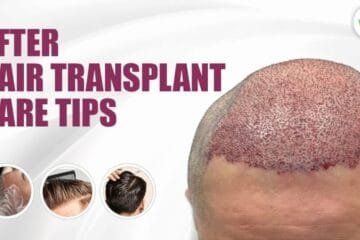Graying hair is a common sign of aging. Many people want to restore their natural hair color. There are various methods to reverse gray hair using treatments and medications. These help stimulate melanin production and improve hair pigmentation. This article covers effective solutions to reduce and reverse graying.
A. Definition and Significance of Graying of Hair
Hair graying, also known as achromotrichia or canities, is a natural aspect of aging. According to reports, 6–23% of the global population will have 50% gray hair by the age of 50. Graying typically starts in the mid-30s for Caucasians, the late-30s for Asians, and the mid-40s for Africans. Graying typically begins:
- Mid-30s for Caucasians
- Late-30s for Asians
- Mid-40s for Africans
B. Role of Melanin in Hair Coloration
Melanin, a pigment produced by melanocytes, determines hair color. There are two main types of melanin: eumelanin, which produces black or brown hues, and pheomelanin, responsible for red and yellow shades. The distribution and concentration of melanin in the hair shaft influence hair color variation in individuals.
Melanin, a pigment produced by melanocytes, determines hair color. There are two main types of melanin:
- Eumelanin – Produces black or brown hues
- Pheomelanin – Responsible for red and yellow shades
The melanin distribution and concentration in the hair shaft determine the hair color.
1. Hair Follicle Structure
Each hair follicle consists of three layers:
- Cuticle – Outer protective layer
- Cortex – Contains melanocytes and determines pigmentation
- Medulla – Innermost part
2. Melanocyte Types and Their Function
- Active Melanocytes – Located in the hair bulb and infundibulum, responsible for producing melanin
- Inactive Melanocytes – Found around arrector pili muscles and peri-matrix, considered melanocyte stem cells
3. Melanogenesis Process
Melanin production depends on the hair growth cycle, which has three phases:
- Anagen (growth phase) – Melanin production occurs
- Catagen (transitional phase) – Melanocyte cells undergo apoptosis
- Telogen (resting phase) – Stem cells remain inactive
Melanogenesis is controlled by three key enzymes:
- Tyrosinase
- GP75
- Tautomerase
Additionally, the MITF (Microphthalmia-associated Transcription Factor) regulates melanogenesis by acting on tyrosinase and dopachrome tautomerase (DCT).
C. Causes of Premature Graying
Premature graying is a rising concern in modern society, with various contributing factors. Family history plays a crucial role, with studies reporting that 65–75% of premature graying cases are hereditary. Other influencing factors include oxidative stress from smoking, pollution, and increased mental stress.
1. Genetic and Environmental Factors
- Family history of premature graying (reported in 65–75% of cases)
- Oxidative stress from smoking, pollution, and UV radiation
- Increased mental stress
2. Metabolic Disorders Linked to Premature Graying
- Cardiovascular Diseases – Myocardial infarction (risk 1.9 times higher)
- Hyperlipidemia – Higher incidence in premature graying cases
- Obesity – Associated with increased graying incidence
- Osteopenia – Increased risk by 4.4 times
- Atopy – Found in 36.5% of premature graying cases
3. Nutritional Deficiencies Affecting Hair Color
Deficiencies in the following minerals and vitamins contribute to graying:
- Copper – Essential for tyrosinase enzyme activity
- Calcium – Required for phosphorylation and activation
- Ferritin, Zinc, Folic Acid, Vitamin B12
4. Medication-Induced Graying
Certain drugs can accelerate hair graying:
- Antiepileptics
- Chloroquine & Hydroxychloroquine
Nutritional deficiencies can further impact melanin production. Copper, essential for tyrosinase enzyme activity, plays a key role in melanin synthesis. Calcium, ferritin, zinc, folic acid, and vitamin B12 deficiencies have also been associated with premature graying. Certain medications, such as antiepileptics, chloroquine, and hydroxychloroquine, have also been reported to trigger premature graying.
D. Pharmacological Approaches to Reversing Gray Hair
There are several pharmacological interventions for reversing gray hair, categorized into anti-inflammatory drugs, melanogenesis stimulators, and vitamin-based treatments.
1. Anti-Inflammatory Medications
Although hair follicles are immune-privileged structures, inflammatory cytokines such as IL-6, IL-2, and TNF-alpha can build up in the peri-follicular area, causing oxidative damage to melanocytic stem cells and melanocytes. This damage contributes to premature graying and disrupts methods to reverse gray hair. It leads to defective melanosome transfer and an impaired ability of keratinocytes to absorb melanin, further accelerating the graying process.
To counteract this, researchers have identified anti-inflammatory drugs that have shown gray hair reversal in some cases. These include:
- Tyrosine Kinase Inhibitors – Imatinib
- Immunomodulators – Thalidomide, Lenalidomide, Cyclosporin A, Adalimumab
- Retinoids – Acitretin, Etretinate
2. Drugs That Stimulate Melanogenesis
Certain medications work by stimulating melanogenesis, enhancing melanin production in hair follicles. Some of these include:
- Psoralen
- Thyroxine
- Tamoxifen
- Leva-Dopa
- Latanoprost
3. Vitamin and Supplement-Based Treatments
Several vitamins and supplements have been found to support hair pigmentation. PABA (p-aminobenzoic acid) has been used in high doses, with some studies reporting visible hair darkening, though results tend to reverse after stopping the treatment. Calcium Pantothenate has also been studied for preventing premature graying. Another promising agent is Melitane (an Alpha-MSH agonist), which works by binding to the melanocortin 1 receptor, thereby triggering melanogenesis.
E. The Role of Cerebrolysin in Hair Repigmentation
Cerebrolysin, a neuropeptide derived from porcine brain, has shown potential in enhancing melanocyte activity and promoting melanin synthesis. A recent pilot study published in the European Journal of Medicine (2021) explored its effects on hair pigmentation. After nine months of treatment, researchers observed:
- A four-fold increase in melanin production
- Significant repigmentation of gray hair
The study suggests that Cerebrolysin may activate stem cells and promote melanocyte differentiation, offering a promising treatment for gray hair reversal.
F. Preventing and Managing Gray Hair
1. Reducing Oxidative Stress
Oxidative stress is a primary cause of hair graying due to the buildup of hydrogen peroxide and hydroxyl radicals in hair follicles. Antioxidants like Methionine, N-Acetyl Cysteine, and Ubiquinol (CoQ10) can help counteract this damage. Supplementing with L-Methyl Folate, Glycine, and Trimethyl Glycine can further support melanin production.
2. Avoiding Harmful Hair Dyes
Most permanent hair dyes contain Ammonium Hydroxide and Paraphenylenediamine (PPD), which damage the hair structure and accelerate graying. These chemicals have also been linked to allergic reactions, contact dermatitis, and long-term cancer risks. Switching to semi-permanent dyes, Henna, or Indigo can help minimize damage.
3. Managing Stress to Prevent Gray Hair
Stress activates sympathetic nerve fibers around hair follicles, leading to excessive melanocyte proliferation and stem cell exhaustion. Practicing meditation, yoga, and mindfulness can help regulate stress and slow down graying.
4. Biohacking Gray Hair with Nutraceuticals
Certain nutraceuticals and topical treatments may help reverse graying. These include:
- Ubiquinol, Vitamin B12, Zinc, Methionine, and N-Acetyl Cysteine
- Grape Seed Extract and Quercetin for anti-inflammatory effects
- Topical Minoxidil, Cyclosporine, and Tacrolimus
- Alpha-MSH agonists (Melitane, Palmitoyl Tetrapeptide-20)
G. Future Possibilities in Gray Hair Reversal
With advancements in stem cell therapy, neurotrophic factors, and immunomodulation, methods to reverse gray hair may soon become clinically validated treatments rather than just cosmetic solutions. Ongoing research in melanocyte activation and oxidative stress management holds great promise for developing effective treatments to reverse gray hair and restore natural pigmentation.
Conclusion
In summary, cerebrolysin and similar treatments hold potential for addressing hair graying by activating neurotrophic factors and enhancing melanin synthesis in hair follicles. The pilot study shows that cerebrolysin may help reverse gray hair by boosting melanocyte activity and melanin production. While these findings are promising, more research is needed to confirm the results and assess long-term safety. Future studies, such as those by Rivertown Therapeutics and the University of Alabama at Birmingham, are exploring combination treatments to preserve melanocyte stem cells and reduce inflammation. These advancements may provide new insights into methods to reverse gray hair effectively.
References:
- Paus R, Müller-Röver S, Van Der Veen C, et al. A comprehensive guide for the recognition and classification of distinct stages of hair follicle morphogenesis. J Invest Dermatol. 1999 Dec;113(6):523-32. doi: 10.1046/j.1523-1747.1999.00737.x. PMID: 10594741.
- Tobin DJ. The cell biology of human hair follicle pigmentation. Pigment Cell Melanoma Res. 2011 Feb;24(1):75-88. doi: 10.1111/j.1755-148X.2010.00745.x. Epub 2010 Nov 9. PMID: 21062352.
- Picardo M, Dell’Anna ML, Ezzedine K, et al. Vitiligo. Nat Rev Dis Primers. 2015 Oct 22;1:15011. doi: 10.1038/nrdp.2015.11. PMID: 27189774.
- Hillebrand GG, Levine MJ, Miyamoto K, et al. Bioengineering of human skin: water and the stratum corneum. Crit Rev Ther Drug Carrier Syst. 1991;7(2):135-56. PMID: 1812986.
- Inoue-Narita T, Hamada K, Sasaki T, et al. Pten deficiency in melanocytes results in resistance to hair graying and susceptibility to carcinogen-induced melanomagenesis. Cancer Res. 2008 May 15;68(10):5760-8. doi: 10.1158/0008-5472.CAN-07-6506. PMID: 18483266.
- Sasaki M, Horikoshi T, Uchiwa H, et al. Up-regulation of tyrosinase gene by nitric oxide in human melanocytes. Biochem Biophys Res Commun. 2000 Jul 5;273(2):481-4. doi: 10.1006/bbrc.2000.2985. PMID: 10873693.














